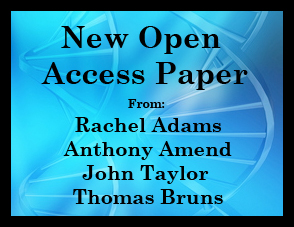Checking out this new paper from Rachel Adams, Anthony Amend, John Taylor and Thomas Bruns: A Unique Signal Distorts the Perception of Species Richness and Composition in High-Throughput Sequencing Surveys of Microbial Communities: a Case Study of Fungi in Indoor Dust – Online First – Springer.
It is open access so anyone out there can get it, read it, have fun with it.
Abstract:
Sequence-based surveys of microorganisms in varied environments have found extremely diverse assemblages. A standard practice in current high-throughput sequence (HTS) approaches in microbial ecology is to sequence the composition of many environmental samples at once by pooling amplicon libraries at a common concentration before processing on one run of a sequencing platform. Biomass of the target taxa, however, is not typically determined prior to HTS, and here, we show that when abundances of the samples differ to a large degree, this standard practice can lead to a perceived bias in community richness and composition. Fungal signal in settled dust of five university teaching laboratory classrooms, one of which was used for a mycology course, was surveyed. The fungal richness and composition in the dust of the nonmycology classrooms were remarkably similar to each other, while the mycology classroom was dominated by abundantly sporulating specimen fungi, particularly puffballs, and appeared to have a lower overall richness based on rarefaction curves and richness estimators. The fungal biomass was three to five times higher in the mycology classroom than the other classrooms, indicating that fungi added to the mycology classroom swamped the background fungi present in indoor air. Thus, the high abundance of a few taxa can skew the perception of richness and composition when samples are sequenced to an even depth. Next, we used in silico manipulations of the observed data to confirm that a unique signature can be identified with HTS approaches when the source is abundant, whether or not the taxon identity is distinct. Lastly, aerobiology of indoor fungi is discussed.
Rachel has written about various things here at microBE.net before including:
- Spores indoors
- Size matters, or what I learned from collaborating with environmental engineers
- Video Conference on Air Sampling Methods
- The trophic interactions of my face
And it is good to see this paper out – I have heard her talk about some of the work in it at various meetings but was not familiar with all the details. Hopefully we can get her to write more about it here.

New at #microBEnet: New paper on interest from Rachel Adams et al. on bias in sequence-based surveys of indoor… http://t.co/JadzgHtnBj
New paper on interest from @Rachel_I_Adams et al. on bias in sequence-based surveys of indoor fungi http://t.co/zyQoA6GlYv via #microBEnet
few highly abundant taxa can skew richness/composition measurments when samples are sequenced to an even depth http://t.co/5N5cMZ6fHk
RT @phylogenomics: New paper on interest from @Rachel_I_Adams et al. on bias in sequence-based surveys of indoor fungi http://t.co/zyQoA6Gl…
New at #microBEnet: New paper on interest from Rachel Adams et al. on bias in sequence-based surveys of indoor… http://t.co/LHGF7U5FeP
RT @phylogenomics: New paper on interest from @Rachel_I_Adams et al. on bias in sequence-based surveys of indoor fungi http://t.co/zyQoA6Gl…
RT @Dr_Bik: New at #microBEnet: New paper on interest from Rachel Adams et al. on bias in sequence-based surveys of indoor… http://t.co/L…